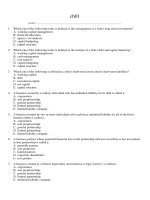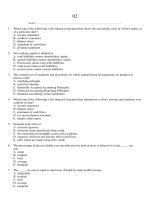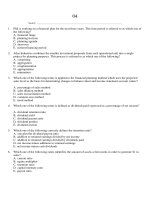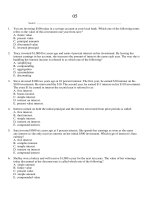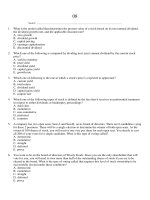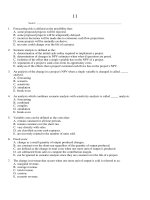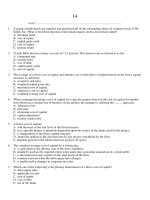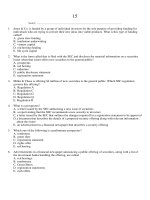Chapter 22 fundamentals of corporate finance 9th edition test bank
Bạn đang xem bản rút gọn của tài liệu. Xem và tải ngay bản đầy đủ của tài liệu tại đây (133.12 KB, 13 trang )
22
Student: ___________________________________________________________________________
1.
Amy is the chief financial officer of a retail toy store. Recently, she decided that the firm should expand
its operations and open two additional stores. Within a very brief period, it was obvious that Amy
had made a very bad decision in opening those stores, given that the economy is in the middle of a
severe recession. In reflecting back on her decision, Amy realizes that she made a bad decision due to a
reasoning error. Which one of the following areas of study best applies to this situation?
A. corporate ethics
B. financial statement analysis
C. managerial finance
D. debt management
E. behavioral finance
2.
Peter has successfully managed the finances of A.D. Leadbetter in a manner that has yielded abnormally
high returns. Due to this success, Peter has decided to publish a newsletter for financial executives so
that he can share his superior financial wisdom with others. There is a very real probability that Peter has
which one of the following characteristics?
A. gambler's fallacy
B. frame dependence
C. overconfidence
D. representativeness heuristic
E. sentiment-based risk attitudes
3.
Anytime Ted analyzes a proposed project, he always assigns a much higher probability of success to
the project than is warranted by the information he has gathered. Ted suffers from which one of the
following?
A. frame dependence
B. overconfidence
C. gambler's fallacy
D. confirmation bias
E. overoptimism
4.
The tendency for a decision maker to search for confirmation that a recent decision he or she made was a
good decision represents which one of the following characteristics?
A. overconfidence
B. overoptimism
C. affect heuristic
D. confirmation bias
E. representativeness heuristic
5.
Which one of the following refers to the fact that an individual may reply differently if a question is asked
in a different manner?
A. loss aversion
B. gambler's fallacy
C. frame dependence
D. overconfidence
E. format reference
6.
A general rule used as the basis for decision making is referred to as:
A. a loss aversion technique.
B. heuristics.
C. self-attribution.
D. narrow framing
E. confirmation bias
7.
Bill feels that he possesses a good dose of "street smarts". Thus, he makes his business decisions based
on how a project feels to him rather than taking the time to financially analyze a project. This type of
behavior is referred to as:
A. overconfidence.
B. endowment effect.
C. money illusion.
D. affect heuristic.
E. sentiment-based risk.
8.
Old Country Productions requires skilled furniture finishers to put the final touches on all of the furniture
it produces. The firm hired two individuals last year who had been students in Mr. Tedwell's wood shop
class in high school. Both of these employees have demonstrated exceptional skills and have already been
promoted to senior finishing positions. The firm currently has an opening for one additional finisher.
Tom, the head of the finishing section, has stipulated that he only wants to interview candidates who
have completed Mr. Tedwell's course. Tom's behavior is typical of someone who has which one of the
following characteristic behaviours?
A. endowment effect
B. framing effect
C. representativeness heuristic
D. narrow framing
E. affect heuristic
9.
In an efficient market, it is believed by some individuals that the actions of traders who constantly buy
and sell on any perceived market mispricings will in effect cause market prices to correctly reflect asset
values. A person who believes that the actions of these traders will not result in correctly valued prices
are most apt to believe in which one of the following?
A. gambler's fallacy
B. limits to arbitrage
C. availability bias
D. false consensus
E. clustering illusion
10. Stewart is a fellow finance student at your school who is addicted to day trading and thus buys and sells
stocks between classes and over his lunch break. He never has time to really analyze a security so just
trades the stock symbols that other investors appear to be trading. Stewart is which one of the following?
A. noise trader
B. arbitrageur
C. crasher
D. regret averter
E. myopic loss averter
11. Which one of the following is an investment risk that investors face in addition to firm-based risk and
market-based risk?
A. management-related risk
B. inflation risk
C. supply chain risk
D. interest rate risk
E. sentiment-based risk
12. Most people would tend to agree that technology stocks were highly overvalued in the late 1990's. This
time period is best described as a technology:
A. crash.
B. circle.
C. bubble.
D. limit.
E. arbitrage.
13. A sudden and severe decline in market prices is best described as a market:
A. crash.
B. revolver.
C. bubble.
D. limit.
E. mispricing.
14. Which one of the following best illustrates an error which you, as a manager, might make due to
overconfidence?
A. overestimating the best outcome expected from a project while underestimating the possibility of a less
favorable outcome
B. assuming that a new project will be profitable since similar projects in the past were successful
C assuming that your expectations of the future outcome from a project are more accurate than the
. expectations of others within your organization
D listening to the advice of subordinates with whom you agree while ignoring the advice of subordinates
. with whom you tend to disagree
E. downplaying the cost of future failure of an existing project since the project has already paid for itself
15. Assume you are an overconfident manager. You are most apt to do which one of the following more so
than you would if you were not overconfident?
A. research a project more thoroughly before committing funds to commence it
B. accept risky projects that turn out to be less profitable than you expected
C. wait until new technology proves its worth before incorporating it into your firm's operations
D. avoid mergers and acquisitions
E. invest excess company cash more conservatively than your peers at other firms
16. Marzella Corp. is analyzing a project that involves expanding the firm into a new product line. The
project includes the construction of a new manufacturing facility and also creating a new distribution
system. The project's financial projections will tend to have which one of the following characteristics if
the person compiling those projections suffers from overoptimism?
A. over estimated construction costs
B. over estimated expenses
C. over estimated net present values
D. under estimated profits
E. under estimated sales estimates
17. When weighing a decision, Kate places greater emphasis on opinions that match her own than she does
on opinions offered by others that disagree with her personal point of view. Kate illustrates which one of
the following?
A. frame dependence
B. overconfidence
C. gambler's fallacy
D. confirmation bias
E. overoptimism
18. Kaiser Marketing recently conducted a survey on behalf of Health Products. The primary purpose of
the survey was to illustrate to Health Products that it was relying on results of previous studies that,
according to Kaiser, were unreliable due to the wording of the survey questions. To prove this point,
Kaiser conducted a two-prong survey. In the first prong, the survey questions were worded such that the
answers tended to sound positive. In the second prong, the survey questions were re-worded such that
the answers tended to convey a negative feeling. Both sets of survey questions should have resulted in
similar results as the information solicited was essentially identical. However, the survey results varied
significantly. This survey best illustrates which one of the following?
A. mental accounting
B. overconfidence
C. self attribution bias
D. confirmation bias
E. frame dependence
19. Recently, a neighbor you have known for years won a lottery and received a $250,000 prize. This
neighbor decided to invest all of his winnings in a new business venture that he knew only had a five
percent chance of success. Previous to this, the neighbor had always been ultra conservative with his
money and had refused to invest in this business venture as recently as last week. Which one of the
following behaviors most applies to your neighbor's decision to invest in this business venture now?
A. overoptimisim
B. affect heuristic
C. loss aversion
D. house money
E. get-evenitis
20. Amy has been investing in stocks so she can accumulate sufficient money to purchase her own home.
These savings are currently valued at $82,500. As recently as last month, her savings were worth in
excess of $110,000. Today, Amy found the perfect house. She knows she can withdraw her savings to
pay on this house and borrow the remaining balance from her father at zero percent interest. However,
Amy is refusing now to buy any house until her savings increase in value back to their $110,000 previous
valuation. Amy is displaying which one of the following behaviors?
A. representativeness heuristic
B. loss aversion
C. house money effect
D. underconfidence
E. confirmation bias
21. Steve purchased a stock last year for $34 a share. The stock increased in value to $36 a share before
declining to its current value of $30. Steve has decided to sell the stock but only if he can receive $34 a
share or better. Steve is suffering most from which one of the following behavioral conditions?
A. representativeness heuristic
B. house money
C. get-evenitis
D. randomness
E. arbitrage reaction
22. Mike is a stock broker and financial planner. Phil is one of Mike's clients. Phil prefers to meet with Mike
just once a year to review his investment portfolio. At their most recent meeting, Phil stated he believes
the stock market is going to decline in value over the next six months. Thus, Phil instructed Mike to sell
every stock he owns that is currently worth more than what he paid to purchase it. Phil also instructed
Mike to retain any stock that would create a capital loss if sold. Phil is displaying the behavior known
as:
A. overconfidence.
B. arbitrage theory.
C. the disposition effect.
D. the house money effect.
E. a confirmation bias.
23. Over the past six months, you have watched as your parent's retirement savings have declined in value
by 45 percent due to a severe financial market downturn. As a result, you have decided that you will
never invest in stocks for your own retirement but will instead keep all of your money in an insured bank
account. Which behavior characteristic have you developed as a result of the market downturn?
A. myopic loss aversion
B. get-evenitis
C. self-attribution bias
D. mental accounting
E. regret aversion
24. Ramon opened a combination laundry and dry cleaning establishment three years ago. Due to his
excellent service and reasonable prices, his business has grown and is doing quite well financially. He
has considered expanding this business by opening another location but keeps putting off that decision
for fear that the second location will not be a success. Ramon is currently displaying which one of the
following behavior characteristics?
A. self-attribution bias
B. overconfidence
C. regret aversion
D. house money effect
E. frame dependence
25. Phyllis is planning for her retirement in fifteen years. She knows that she can currently live reasonably
well on $38,000 a year given that she is debt-free. Based on her family history she expects to die ten
years after she retires. Thus, she computes her retirement need as $38,000 a year for 10 years. Which one
of the following behaviors applies to Phyllis?
A. regret aversion
B. money illusion
C. self-attribution bias
D. endowment effect
E. myopic loss aversion
26. Kate is attempting to sell her house for $260,000. Fred lives across the street in an identical house. Fred
recently stated to his wife that Kate's house is probably worth only $250,000 but that once she sells her
house, he would like to put their house on the market at $285,000 and then move into a condominium.
Which one of the following behaviors applies to Fred?
A. myopic loss aversion
B. house money effect
C. money illusion
D. self-attribution bias
E. endowment effect
27. You recently overheard your boss telling someone that if he'd actually crunched some numbers and done
some analysis instead of just going with his instincts that he never would have opened the new store in
Centre City. Which one of the following caused your boss to make a bad decision?
A. regret aversion
B. endowment effect
C. money illusion
D. affect heuristic
E. representativeness heuristic
28. Roger's Meat Market is a chain of retail stores that limits its sales to fresh-cut meats. The stores have
been very profitable in northern cities. However, when two stores were opened in the south, both lost
money and had to be closed. Roger, the owner, has now concluded that no southern-based store should be
opened as it would not be profitable. Which one of the following applies to Roger?
A. confirmation bias
B. endowment effect
C. money illusion
D. affect heuristic
E. representativeness heuristic
29. Up until three years ago, A.C. Dime opened an average of ten new retail stores a year. One of those stores
had to be closed within two years due to poor sales. This 90 percent success ratio was fairly steady for
over 30 years. Starting three years ago, the firm has opened 40 new stores and every one had significant
profits within 6 months. Management believes their recent success is not just a random event and that all
future stores will be profitable. Thus, the managers have decided to open a minimum of 15 new stores
each year. The managers are suffering from:
A. arbitrage limitations.
B. anchoring and adjustment.
C. aversion to ambiguity.
D. the clustering illusion.
E. myopic aversion.
30. You are employed as a commission-based sales clerk for a cosmetics retail store. You know that on
average, exactly 50 percent of the customers that enter your store will make at least one purchase. Thus
far this morning, you have waited on eight customers without making a single sale. You are convinced
that the next customer you wait on will buy something. This belief is known as:
A. aversion to ambiguity.
B. the law of small numbers.
C. anchoring and adjusting.
D. gambler's fallacy.
E. false consensus.
31. You don't particularly like to shop so only go to the mall once a month. To help make the trek more
enjoyable, you always have lunch at the restaurant located inside the mall. Since you are such a creature
of habit, you always order the same meal. You've noticed that the price of that meal has increased every
time you have been there over the past six months. Thus, you expect the meal to increase in price next
month. This is an example of which one of the following?
A. recency bias
B. anchoring and adjustment
C. frame dependence
D. aversion to ambiguity
E. clustering illusion
32. You started an online business three weeks ago. Thus far, you have averaged 10 sales a day, which is one
sale for every five hits. You are now considering giving up your day job and becoming a full-time online
retailer. You have calculated the amount of income you can earn based on 10 sales a day and know that
level of income would support you in a comfortable fashion. The belief that you will have 10 sales per
day on average if this becomes your full-time occupation is based on which one of the following?
A. mental accounting
B. anchoring and adjustment
C. law of small numbers
D. bubble and crash theory
E. confirmation bias
33. You are a hard-charging manager who doesn't really like to sit at a desk for too long. You prefer to gather
information quickly, make a decision, and move on to the next item on your agenda. Which one of the
following applies to you?
A. availability bias
B. arbitrage limits
C. law of small numbers
D. representativeness heuristic
E. regret aversion
34. You have saved a total of $200,000 over the past several years. Jane, a trusted business associate, recently
approached you with an offer. She has offered you a partnership in a new firm that she expects to be
exceedingly profitable. Your initial investment in the partnership would be $125,000. However, Jane
cannot give you any odds on that success occurring. You have decided to keep your $125,000 and forego
this opportunity simply because you don't know the probability of success. Which one of the following
behavior characteristics do you have?
A. aversion to ambiguity
B. recency bias
C. sentiment-based risk aversion
D. clustering illusion
E. money illusion
35. You are the manager of a retail store. You believe the economy is in a recession and that sales for the
month will be unusually slow. Since you have complete discretion over the pricing at your location, you
decide to have a store-wide sale and offer 10 percent off all merchandise for a 3-day period. You don't
expect your superiors to criticize this decision as you believe they, along with the majority of the other
store managers, feel the same way about the economy as you do. Which one of the following applies to
you?
A. recency bias
B. law of small numbers
C. gambler's fallacy
D. false consensus
E. money illusion
36. Which of the following create limits to arbitrage?
I. risks related to an individual firm
II. implementation costs
III. rational traders
IV. noise traders
A. I and III only
B. II and IV only
C. I, II, and III only
D. I, II, and IV only
E. I, II, III, and IV
37. AB Industries is an all-equity firm that has $8 per share in cash and a book value per share of $12. At
which one of the following market prices would you know with absolute certainty that the stock was
mispriced?
A. $7
B. $8
C. $10
D. $12
E. $13
38. Which of the following have been offered as factors contributing to the market crash of 1987?
I. requirement for only a 10 percent cash payment to purchase a stock
II. program trading
III. irrational investors
IV. preceeding bear market
A. I and III only
B. I and IV only
C. II and III only
D. I, II, and III only
E. I, II, and IV only
39. Which one of the following statements related to market crashes is correct?
A. Financial market crashes are unique to the United States.
B. A severe market decline tends to occur over a multi-day period.
C. Once the market finally crashed in 1929, stock prices began to slowly increase again.
D The market crash of 1987 occurred on a day when trading volume was light indicating there were a
. limited number of irrational investors involved.
E. Actions in Washington, D.C. may have helped contribute to the market crash in 1929 but not to the
1987 crash.
40. Which one of the following statements is true?
A. Market crashes tend to be accompanied by low market volume.
B. The Asian market crash was followed by a quick recovery.
C The market crash of 1929 and the crash of 1987 are very similar in both the percentage decline in
. market value and in the ensuing market recovery.
D. Market crashes tend to follow market bubbles.
E. Market bubbles and crashes prove that financial markets are inefficient.
41. Historical returns support which one of the following statements?
A. Financial markets are highly inefficient as suggested by behavioral finance.
B. Professional money managers tend to outperform the Vanguard 500 index fund about 55 percent of the
time on average.
C. The longer the time span, the more apt a professional money manager is to outperform an index fund,
such as the S&P 500.
D. Historical data supports the statement that arbitrage is unlimited and results in a totally efficient
market.
E. The financial markets appear to be efficient because, on average, they outperform professional money
managers.
42. Which of the following statements are correct?
I. Many professional fund managers are paid well but fail to outperform as expected.
II. Professional fund managers that have tenures in excess of ten years, tend to consistently outperform
the market on a long-term basis.
III. If a market is truly efficient, then all investments in that market are zero net present value
opportunities.
IV. Actively managing a fund appears to be the key to outperforming the market.
A. I and III only
B. II and IV only
C. II and III only
D. I, II, and III only
E. I, II, III, and IV
43. Provide an example of a managerial decision that illustrates each one of the following behaviors:
Behavior: Overconfidence
Example:
Behavior: Affect heuristic
Example:
Behavior: Loss aversion
Example:
44. Explain 1) the concept of house money, 2) why the house money concept is such a common behavior for
so many individuals and 3) why house money is an irrational behavior.
45. Explain why a low-priced, low trading volume stock is more apt to present limits to arbitrage than is a
high-priced, high trading volume stock.
22 Key
1. E
2. C
3. E
4. D
5. C
6. B
7. D
8. C
9. B
10. A
11. E
12. C
13. A
14. C
15. B
16. C
17. D
18. E
19. D
20. B
21. C
22. C
23. A
24. C
25. B
26. E
27. D
28. E
29. D
30. D
31. A
32. C
33. A
34. A
35. D
36. D
37. A
38. C
39. B
40. D
41. E
42. A
Feedback: Refer to sections 22.2, 22.3, and 22.4
43. Student answers will vary but should correctly display the type of behavior indicated.
Feedback: Refer to section 22.3
44. House money relates to the concept that individuals treat money differently depending upon the source of that money. They are more
conservative with dollars they have had to work hard to earn and less so with dollars that have been easy to obtain. The term "house money"
relates this concept to gamblers who are willing to lose their prior winnings (the house's money) but who are unwilling to lose their initial
investment (personal money). This behavior is irrational because any dollar you posses has equal purchasing power.
Feedback: Refer to section 22.5
45. A low-priced stock may be less known to investors causing those investors to be more noise traders than informed traders. Further, any trading
by a rational trader will tend to cause the stock price to move if the trade is of significant size. Rational traders with limited dollars may not trade
in the stock due to the potential for trading costs to outweigh any profit from a mispricing.
22 Summary
Category
AACSB: N/A
AACSB: Reflective thinking
Blooms: Analysis
Blooms: Comprehension
Blooms: Knowledge
Difficulty: Basic
Difficulty: Intermediate
Learning Objective: 22-1
Learning Objective: 22-2
Learning Objective: 22-3
Learning Objective: 22-4
Ross - Chapter 22
Section: 22.1
Section: 22.2
Section: 22.2, 22.3 and 22.4
Section: 22.3
Section: 22.4
Section: 22.5
Section: 22.6
Topic: Affect heuristic
Topic: Availability bias
Topic: Aversion to ambiguity
Topic: Behavioral finance
Topic: Bubble
Topic: Clustering illusion
Topic: Confirmation bias
Topic: Crash
Topic: Disposition effect
Topic: Endowment effect
Topic: False consensus
Topic: Frame dependence
Topic: Gamblers fallacy
Topic: Heuristics
Topic: House money
Topic: Irrational behavior examples
Topic: Law of small numbers
Topic: Limits to arbitrage
Topic: Loss aversion
Topic: Loss aversion, get-evenitis
Topic: Market bubbles and crashes
Topic: Market crash of 1987
Topic: Market crashes
Topic: Market efficiency
Topic: Market efficiency and professional managers
Topic: Market mispricing
Topic: Money illusion
Topic: Myopic loss aversion
Topic: Noise trader
Topic: Overconfidence
Topic: Overoptimism
Topic: Recency bias
Topic: Regret aversion
Topic: Representativeness heuristic
# of Questions
42
3
2
24
19
41
4
9
12
13
13
45
1
7
1
11
12
11
2
2
1
1
1
1
1
2
1
1
1
1
2
1
1
2
1
1
3
1
1
1
1
1
1
1
1
1
1
1
3
2
1
1
2
Topic: Sentiment-based risk
1
